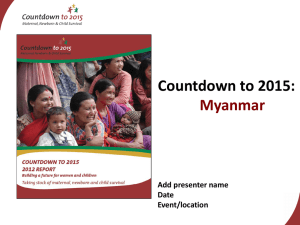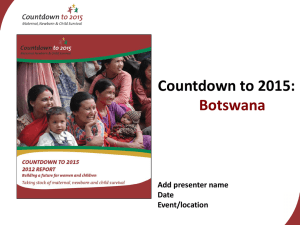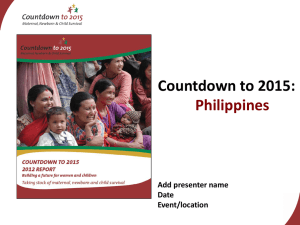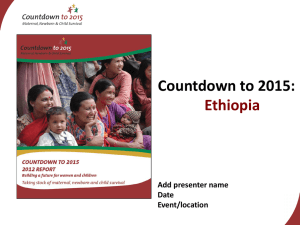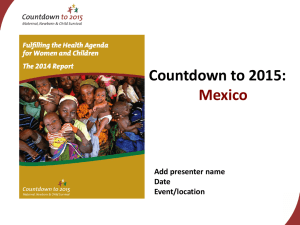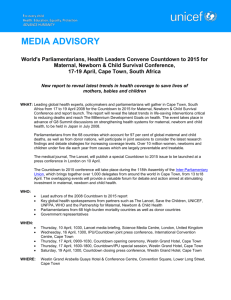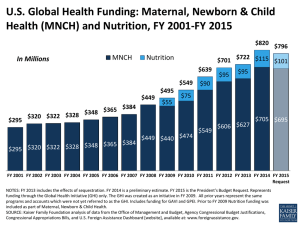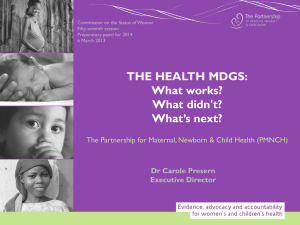Uganda - Countdown to 2015
advertisement
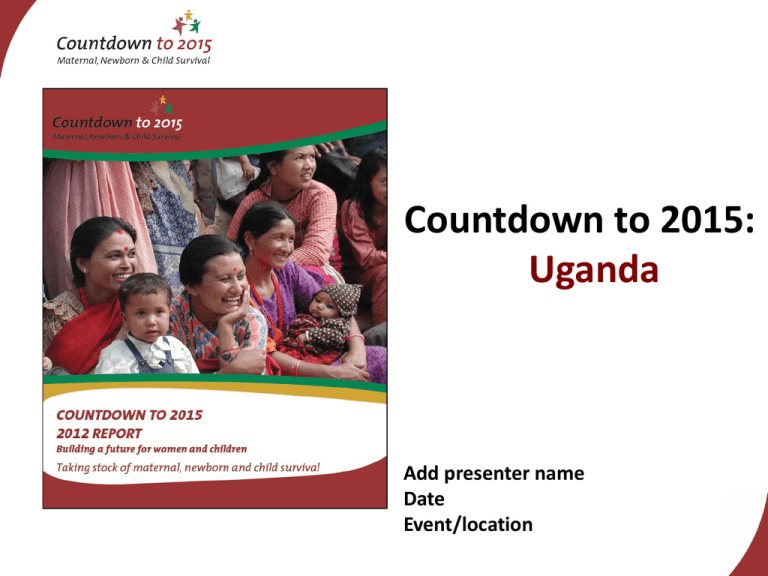
Countdown to 2015: Uganda Add presenter name Date Event/location Notes for the presenter on adapting this presentation • Personalise with photos, charts • Data presented are based on best available data up to mid-2012. When presenting, mention more recent studies or data. (2010 mortality on slide #18 added) • Select which slides are appropriate for the audience. For example: Slides are provided for each figure presented in the country profile; select from these (choosing all or a few depending on needs) • When adapting this for a country or sub-national Countdown process add sub-national level data • Review the Speaker Notes, adapt according to your audience and purpose Purpose of this presentation • To stimulate discussion about Uganda country data, especially about progress, where we lag behind, and where there are opportunities to scale up • To provide some background about Countdown to 2015 for MNCH, the indicators, and data sources in the country profiles • To show examples of tools for monitoring progress, sharing information and improving accountability Outline 1. Countdown to 2015: Background 2. Uganda Countdown profile 3. Country Countdown process Part I Countdown to 2015: Background What is Countdown? A global movement initiated in 2003 that tracks progress in maternal, newborn & child health in the 75 highest burden countries to promote action and accountability Countdown aims • To disseminate the best and most recent information on country-level progress • To take stock of progress and propose new actions • To hold governments, partners and donors accountable wherever progress is lacking What does Countdown do? • Analyze country-level coverage and trends for interventions proven to reduce maternal, newborn and child mortality • Track indicators for determinants of coverage (policies and health system strength; financial flows; equity) • Identify knowledge and data gaps across the RMNCH continuum of care • Conduct research and analysis • Support country-level Countdowns • Produce materials, organize global conferences and develop web site to share findings 9 75 countries that together account for > 95% of maternal and child deaths worldwide Countdown moving forward Four streams of work to promote accountability, 2011-2015 • Responsive to global accountability frameworks -Annual reporting on 11 indicators for the Commission on Information and Accountability for Women’s and Children’s Health (COIA) -Contribute to follow-up of A Promise Renewed/Call to Action • Production of country profiles/report and global event(s) • Cross-cutting analyses • Country-level engagement Part 2 Uganda Countdown country profile Main findings data on the profile WhatRange doesofCountdown monitor? • Progress in coverage for critical interventions across reproductive, maternal, newborn & child health continuum of care • Health Systems and Policies – important context for assessing coverage gains • Financial flows to reproductive, maternal, newborn and child health • Equity in intervention coverage Sources of data The national-level profile uses data from global databases: • Population-based household surveys • UNICEF-supported MICS • USAID-supported DHS • Other national-level household surveys (MIS, RHS and others) • Provide disaggregated data - by household wealth, urbanrural residence, gender, educational attainment and geographic location • Interagency adjusted estimates U5MR, MMR, immunization, water/sanitation • Other data sources (e.g. administrative data, country reports on policy and systems indicators, country health accounts, and global reporting on external resource flows etc.) Mortality Mortality data through 2010: 2011 child mortality data was released in late 2012: Under-five mortality rate (U5MR)= 90 deaths per 1000 live births Infant mortality rate (IMR) = 58 deaths per 1000 live births Neonatal mortality rate (NMR) = 28 deaths per 1000 live births Cause of death Leading direct causes: Haemorrhage – 34% Hypertension – 19% Unsafe abortion – 9% Sepsis – 9% Understanding the cause of death distribution is important for program development and monitoring Cause of death Leading causes: Neonatal – 28% Pneumonia – 16% Malaria – 13% Diarrhoea – 10% HIV/AIDS – 7% Undernutrition is a major underlying cause of child deaths Demographics Countdown to 2015 Report. 2012. Variable coverage along the continuum of care Maternal and newborn health Maternal and newborn health Maternal and newborn health Other maternal and newborn health indicators Countdown to 2015 Report. 2012. Child health Child health Child health Child health Child health Child health Water and sanitation Water and sanitation MNCH policies • NO - Maternity protection in accordance with Convention 183 • YES - Specific notifications of maternal deaths • PARTIAL - Midwifery personnel authorized to administer core set of life saving interventions • YES - International Code of Marketing of Breastmilk Substitutes • YES - Postnatal home visits in first week of life • YES - Community treatment of pneumonia with antibiotics • PARTIAL - Low osmolarity ORS and zinc for diarrhoea management • - Rotavirus vaccine • - Pneumococcal vaccine Systems and financing for MNCH • Costed national implementation plans for MNCH: Yes • Density of doctors, nurses and midwives (per 10,000 population): 14.3 (2005) • National availability of EmOC services: 34% (2002-2003) (% of recommended minimum) • Per capita total expenditure on health (Int$): $83 (2010) • Government spending on health: 12% (2010) (as % of total govt spending) • Out-of-pocket spending on health: 50% (2010) (as % of total health spending) • Official development assistance to child health per child (US$): $13 (2009) • Official development assistance to maternal and newborn health per live birth (US$): $17 (2009) Equity Uganda The wide bars for some indicators show important inequalities in coverage. Inequality is greatest for family planning, skilled birth attendant, and 4+ antenatal care visits. Other interventions show much smaller gaps in coverage. Part 3 Country Countdown Benefits and process Why have a Country Countdown? Data used for action • Promote use of evidence and national or subnational data in decision making • Increase public & politicians awareness of RMNCH needs • Highlight priorities for strengthening national data systems Resources maximised • Assess current domestic & external resources for RMNCH • Links resources used with outcomes obtained • Promote more efficient and equitable use of resources Health outcomes improved • Increase advocacy for accelerated improvements for the health of women, newborns & children, • Accountability mechanism, especially to reach the poorest Country-level Engagement: Guiding Principles Program action cycle Collect and analyze data and assess system gaps and opportunities Track progress for coverage and equity, inputs and outcomes ACCOUNTABILITY Prioritize and plan using data, identify resource gaps, equity gaps ADVOCACY Policy change, program, implementation Country Countdown process can help strengthen your national program action cycle Country Countdown experiences Senegal, 2006 • High level engagement of key partners (MoH/MoF, supported by UNICEF) • Strategic planning meeting for scale-up of effective MNCH interventions Zambia, 2008 • MoH initiated and convened/supported by WHO & UN partners • National prioritization meeting for MNC mortality reduction Nigeria, 2011 • FMOH convened with Save the Children and many partners • Country report and 36 state profiles, • Launched by First Lady and health care professionals especially Paediatricians Country Countdowns: Key steps 1. Preparation/planning • Form core group to coordinate technical analysis and planning, develop workplan/budget, Ensure wide stakeholder inputs • 2. Process with data content and analysis • • • Sub-national data – disaggregated to district/ provincial levels Focus on equity – geographic, ethnic, economic, and social factors Recommendations for solutions – policy and programme 3. Products/materials: National and sub-national profiles, link to existing tracking and meetings 4. Country Countdown event and media outreach 5. Follow-up: MOH, key donors/stakeholders • • Use evidence and data in national planning processes Involve civil society in monitoring Role of in-country partners/MoH • • • • • • • Coordination of national and global partners Identify best data sources Conduct outreach to ensure participation of key local partners/stakeholders Provide technical and financial support Analyze data, produce messages Publicize results Follow-up on recommendations Role of Global Countdown Technical assistance to support countries: • Assess data quality and availability • Help as needed with data analysis and the development of sub-national profiles and other products • Conduct regional capacity-building workshops • Mobilize south-south and global learning through sharing experiences and lessons learned Thank you! Optional additional slides Equity profiles Uganda Coverage levels in poorest and richest quintiles Coverage levels in the 5 wealth quintiles Co-coverage of health interventions Composite coverage and coverage gap
